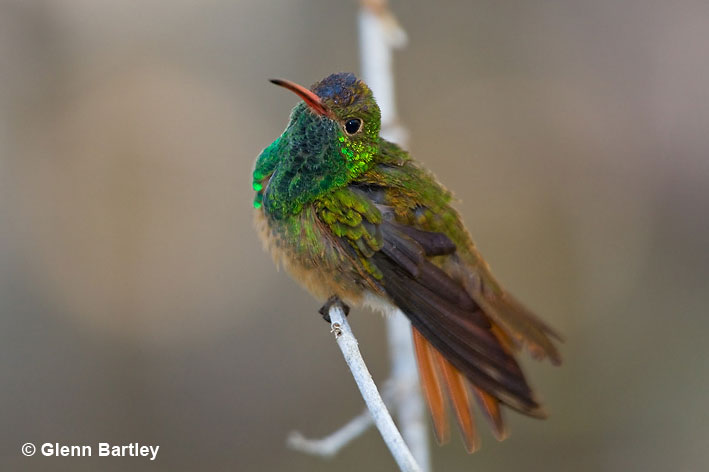
How long do hummingbirds live? These tiny feathered dynamos certainly live in the fast lane! Like insects, they have shiny colors and are always on the move.
With that in mind, it would seem that they can’t live for very long. However, even though hummingbirds are small, they are still birds and live for more years than most people expect.
See this article to learn all about the hummingbird life cycle and how long these surreal birds can live!
On this page
Hummingbird Lifecycle
Eggs
Most hummingbirds start nesting when they are one year old. Female hummingbirds build small nests made of lichens, moss, spider silk, and other soft materials.
Depending on the species, they can construct it in different habitats, such as a small fork of a tree or bush, underneath leaves or other sources of shade. The tropical hermits also make elongated nests hidden underneath a broad understory leaf.
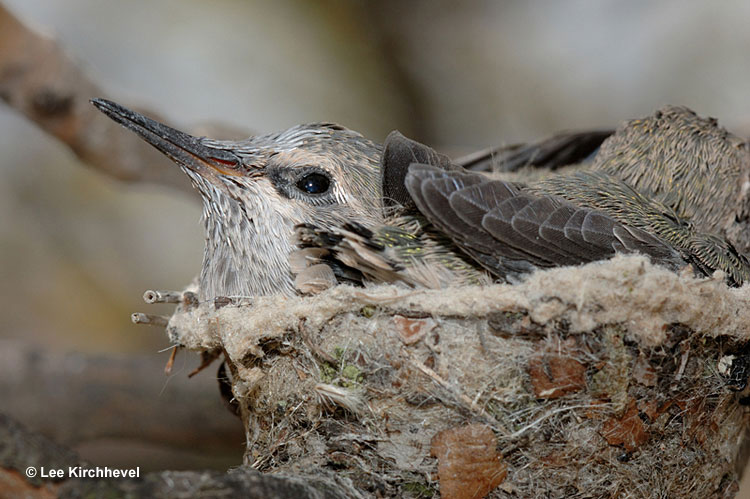
It’s no surprise that hummingbird eggs are the smallest of any bird. They can be as small as coffee beans and have plain, white coloration. The tiniest eggs are laid by the smallest bird, the Bee Hummingbird. Its eggs are a mere 0.275 inches long and weigh 0.0009 ounces!
Learn more: Hummingbird Nests & Eggs
The biggest hummingbird species, the aptly named 9-inch-long Giant Hummingbird, also lays two plain white eggs. However, at 0.826 inches in length, they are much larger than the eggs of other hummingbird species. They are even a little bit bigger than the eggs of Tree Swallows and some other small birds.
After laying two eggs, female hummingbirds incubate them for two to three weeks. She stays on the nest all night long and 75% of the time during the day. However, she briefly leaves to feed five or six times each day.
NB! Do you have a hummingbird feeder in your garden? See out our best picks here.
Nestlings
After 15 to 20 days, baby hummingbirds hatch as tiny, naked, helpless birds. Hatchling Ruby-throated Hummingbirds only weigh 0.021 ounces each! They can be pink or have slate gray coloration, and have red or rich orange-colors on the inside of their mouths.
As soon as they hatch, the mother hummingbird broods her babies to keep them warm. She does this for more than 80% of the time until they are nine days old.
When not brooding, she feeds her babies by regurgitating bits of insects and nectar directly into their open mouths.
The baby birds know when their mother has arrived to the nest when they feel the small breeze made by her beating wings. She also gets their attention with quiet, short calls. The tiny birds react by pointing their beaks up and opening their mouths to receive food.
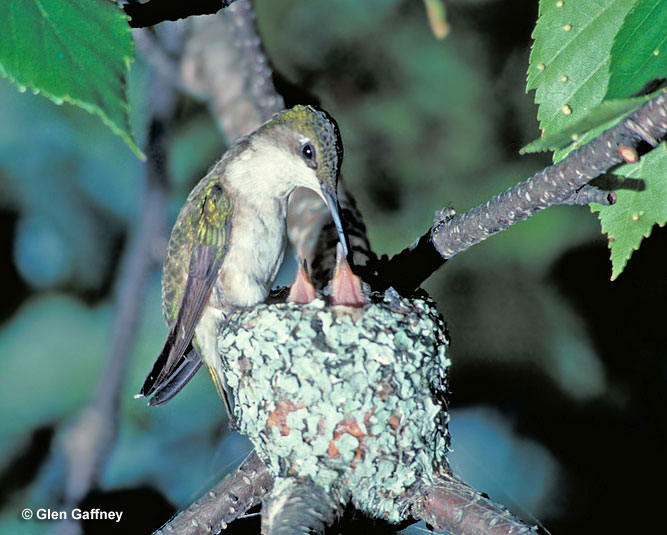
Baby hummingbirds grow quickly, usually 0.01 ounces per day while they are in the nest. A week after hatching, they show some small pinfeathers and open their eyes. At that time, their mother begins to brood them less often and they start beating their wings a week later.
The baby hummingbirds typically leave the nest 18 to 20 days after hatching.
Fledglings
After exercising their wings for several days, baby hummingbirds suddenly fledge and leave their nest. On their first flight, they grasp the edge of the nest with their feet before zipping to a nearby perch. Once they make that first flight, they might stay near the nest but don’t usually return to it.
At this time in their life, young hummingbirds are quite a bit heavier than their parents. They need to live off of this extra weight while they learn to feed on their own.
Although their mother continues to feed the fledgling hummingbirds for another week after leaving, they also practice foraging by themselves.
While they are learning how to feed themselves, baby hummingbirds stick out their tongue to touch all sorts of objects. At the same time, they practice flying and hovering in front of flowers. Eventually, they learn how to find and drink nectar, probably focusing in on red flowers and other types of flowers with certain colors and shapes.
At first, fledgling hummingbirds are easily recognized by their shorter beaks and female-type coloration. Juveniles of some species can also be recognized by plumage that has patches of iridescence.
By 30 days of age, the young hummingbirds have beaks just as long as their parents.
NB! Do you have a hummingbird feeder in your garden? See out our best picks here.
Adulthood
Hummingbirds become adults at one year of age. This is when they start to breed and also when they have acquired full adult plumage. Unlike juvenile hummingbirds, adults have long bills and show complete plumage with all of their full colors.
For example, adult male hummingbirds have a full, iridescent gorget or other shining colors associated with adult birds. Adult female hummingbirds can look a lot like juvenile birds but aren’t as “washed out” and have more contrasting colors.
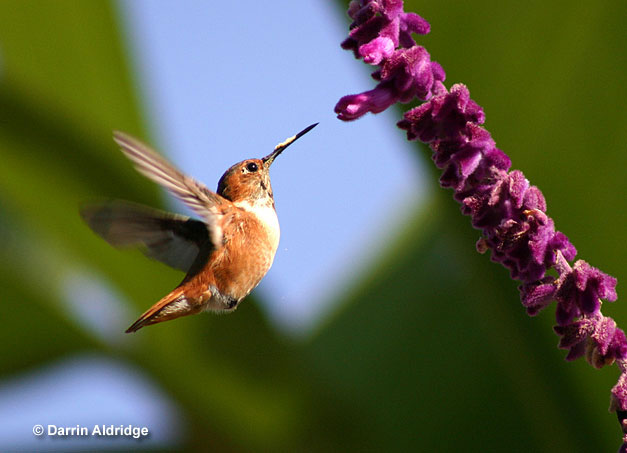
Like adults of other bird species, adult hummingbirds spend part of the year nesting and raising young.
Females carry out this duty while males sing from perches and forage. Although most hummingbirds have simple songs, many have impressive flight displays and some tropical species sing complex songs that mimic other bird species.
They spend the rest of their time looking for flowering plants to feed on, defending their feeding territory, and avoiding predators. Adult Ruby-throated Hummingbirds and some other species, such as the Allen’s Hummingbird, also migrate long distances to and from North America and Central America, twice per year!
However, most hummingbird species are permanent residents, and several have ranges restricted to small mountain ranges or other limited areas.
Can You Tell If A Hummingbird Is Getting Older?
In the wild, it is very difficult to tell if a hummingbird is getting older. Older hummingbirds have the same plumage as younger adults and act the same.
Sadly, as is common with most animals, when they slow down or show other signs of getting older, predators are quick to move in and catch them.
However, as long as they can still react quickly enough and are healthy, older hummingbirds act like younger birds. They forage the same, defend territories, and migrate just as far.
NB! Do you have a hummingbird feeder in your garden? See out our best picks here.
So, How Long Do Hummingbirds Typically Live?
On average, in the wild, hummingbirds can live to be anywhere from 7 to 12 years of age. Although it is very difficult to study hummingbirds and see how long they live, recaptures of banded Ruby-throated Hummingbirds have shown that most probably live to be 5 years of age.
Related: How long do birds live?
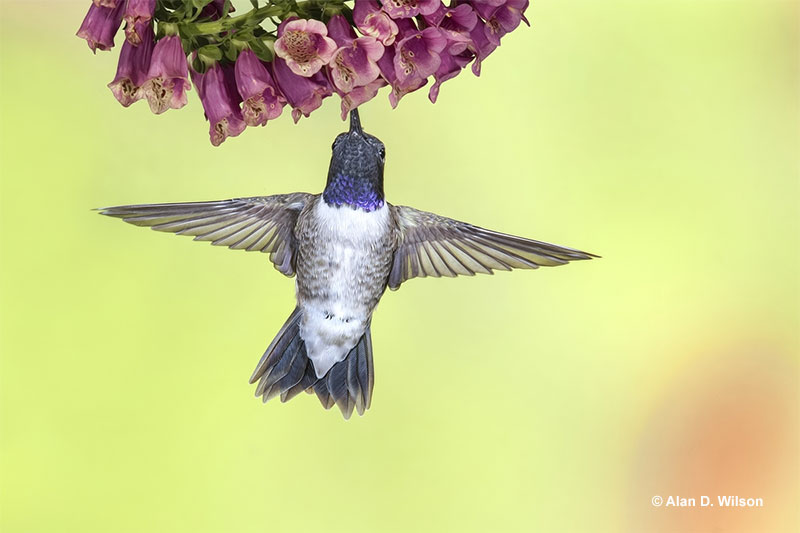
The oldest recaptured female Ruby-throated Hummingbird was nine, while the oldest male was seven. Some other hummingbird species also seem to live longer than the Ruby-throated Hummingbird. While nothing is known about the lifespan of tropical hummingbirds, bigger species like the Giant Hummingbird might live to be 15 or 20.
Want to learn more about hummingbirds? See the profiles of Anna’s Hummingbird and Calliope Hummingbird to get started!
NB! Do you have a hummingbird feeder in your garden? See out our best picks here.
Interesting Facts About Hummingbirds & Their Lives
- The oldest known hummingbird was a female Broad-tailed Hummingbird that lived to be at least 12 years old. One recaptured Buff-bellied Hummingbird was 11. For Rufous Hummingbirds, the recorded record is 8 years, while for Black-chinned Hummingbirds, the recorded oldest specimen was 11 years old.
- The average lifespan of a hummingbird is probably three to five years, but their life expectancy depends on several factors.
- Many hummingbirds die during their first year of life. This is typical for birds and most other animal species. Generally, young hummingbirds die because they don’t learn how to forage well enough or don’t know how to avoid predators.
- Studies have shown that female hummingbirds tend to live longer than males. Males might die younger because they expend a lot of energy fighting and defending territories.
- A certain percentage of Ruby-throated Hummingbirds are believed to perish when they fly across the Gulf of Mexico during spring migration.
- These little creatures have to be careful around several types of predators. In urbanized and farming areas, domestic cats are believed to kill many hummingbirds. Other common dangers include hawks, Merlins, Kestrels, Loggerhead Shrikes, and even Bullfrogs!
- Hummingbird’s high metabolism make them very susceptible to starvation. If they don’t find food within a few hours, these tiny birds can quickly fall into a coma and die! With that in mind, if you see a hummingbird entangled in a spider web, or acting sleepy, help by freeing the bird and giving it some sugar water on your finger. You’ll probably be saving its life!
- Two of the most common reasons for hummingbird mortality are dying of starvation (mostly in the first year of life) and flying into windows. We can help hummingbirds by maintaining hummingbird feeders, planting plants they feed on, and making our windows “bird collision-proof.”
- Interestingly, in colder climates, hummingbirds can enter a stage called ‘torpor,’ which is similar to hibernation. This can help them save energy.
Frequently Asked Questions
Can you tell the age of a hummingbird?
Yes, you can roughly tell the age of some hummingbirds. If a hummingbird has a smaller beak than normal, it’s probably a month old. However, if it has full adult plumage, it can be anywhere from a year to five of even ten years of age.
What is the average lifespan of hummingbirds?
The average lifespan of hummingbirds is five years of age.
How old was the oldest hummingbird?
The oldest hummingbird known was 12 years old. This was a recaptured, banded female Broad-tailed Hummingbird.
Please let us know in the comments, what do you love about hummingbirds? Why do they captivate your mind?


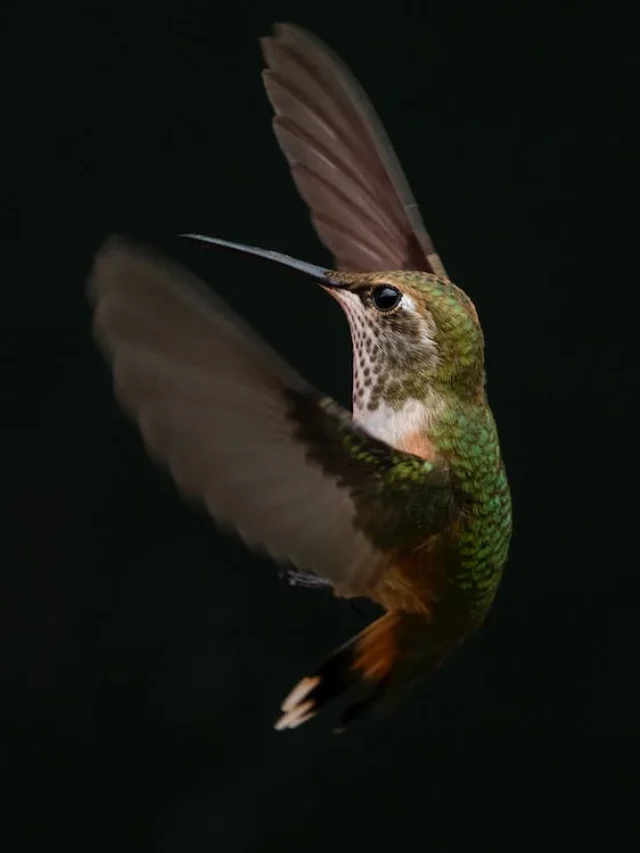
Sue Ortez
Saturday 4th of November 2023
I love all birds. I'm very fascinated with the hummingbird as they are so tiny and fast. The coloring of them. I love watching them. So I put out lots of feeders for the and plants for them and bees . I love honey so want the bees to have lots of nectar.
Patrick O'Donnell
Wednesday 8th of November 2023
@Sue- We love them too, their colors really are incredible! Thank you for helping the birds and bees, we need as many people as possible to help our beautiful birds and insects.
Julie
Wednesday 25th of October 2023
I have loved hummers for a very long time and have feeders everywhere! One time I was on my balcony waiting for my little friends to visit and this huge swarm of gnats were hovering about 10 feet away and then about 50 hummers swept out of nowhere and gobbled up every single gnat in about 30 seconds then did a flight dance that was spectacular to watch. I like to think that they did it for my benefit!! Another time, I was refilling my feeders and was wearing a red sweatshirt and this one little dude flew up to me, hovered near my face as if to say thank you, then took a drink and flew away.it was amazing. Those are just two of my hummer stories. I live in Santa Barbara CA and we have some that live here year round. If I leave my door (to the balcony) open I sometimes have visitors.They don't stay long and return to the balcony, I am blessed.
Patrick O'Donnell
Thursday 26th of October 2023
@Julie- Thank you for sharing your experiences! Your balcony sounds like a pretty cool place.
Patricia black
Wednesday 25th of October 2023
Very good reading.im in sequim Washington. Hummingbirds stay year around. Same couple .and one Single.one trying to steal female. They'll sit on the feeder and start chirping to get my attention.i too make same simular sound.and we take turns.there getting very friendly.i sit in my porch chair,and usually the male fly up.2 ft in front of face .and check me out.. I could go on an on. Thank you again..
Patrick O'Donnell
Thursday 26th of October 2023
@Patricia- Glad you liked the post! How nice to have to connect with hummingbirds like that!
Ty Leland
Wednesday 25th of October 2023
Love watching hummingbirds come to the feeders. They are so beautiful.
Patrick O'Donnell
Thursday 26th of October 2023
@Ty- Yes, aren't they wonderful?
Sue
Tuesday 24th of October 2023
I have hung a hummingbird feeder in my kitchen window for many years. I know they are back for the summer when I see one hovering at my window. So I know it is one that flew thousands of miles to return to my yard and feeder for another summer! How do they do that? Amazing!
Patrick O'Donnell
Tuesday 24th of October 2023
@Sue- Yes, they really are incredible!